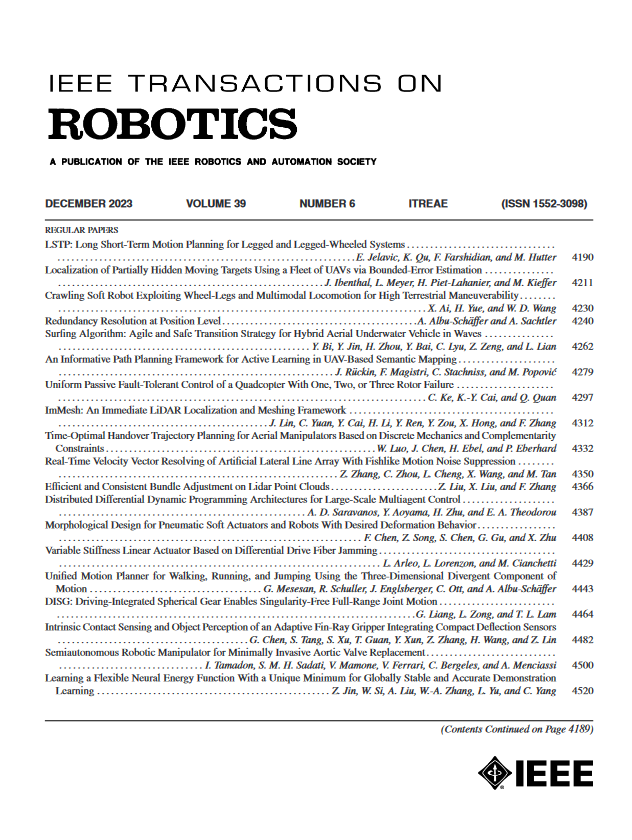动态环境中拓扑驱动的并行轨迹优化
IF 9.4
1区 计算机科学
Q1 ROBOTICS
引用次数: 0
摘要
在复杂的动态环境中导航的地面机器人必须计算无碰撞轨迹,以安全有效地避开障碍物。非凸优化是一种常用的实时轨迹计算方法。然而,这些方法往往收敛于局部最优解,并且经常在不同的局部最小值之间切换,导致机器人运动效率低下和不安全。在这项工作中,我们提出了一种新的拓扑驱动的动态环境轨迹优化策略,该策略规划了多个不同的规避轨迹,以提高机器人的行为和效率。一个全局规划器迭代地在不同的同伦类中生成轨迹。然后,这些轨迹由并行工作的本地规划人员进行优化。虽然每个规划器共享相同的导航目标,但它们在局部受到特定同伦类的约束,这意味着每个局部规划器尝试不同的规避策略。然后,机器人以后退视界的方式执行成本最低的可行轨迹。我们在一个在行人中导航的移动机器人上证明,我们的方法比现有的规划器产生更快的轨迹。本文章由计算机程序翻译,如有差异,请以英文原文为准。
Topology-Driven Parallel Trajectory Optimization in Dynamic Environments
Ground robots navigating in complex, dynamic environments must compute collision-free trajectories to avoid obstacles safely and efficiently. Nonconvex optimization is a popular method to compute a trajectory in real time. However, these methods often converge to locally optimal solutions and frequently switch between different local minima, leading to inefficient and unsafe robot motion. In this work, we propose a novel topology-driven trajectory optimization strategy for dynamic environments that plans multiple distinct evasive trajectories to enhance the robot's behavior and efficiency. A global planner iteratively generates trajectories in distinct homotopy classes. These trajectories are then optimized by local planners working in parallel. While each planner shares the same navigation objectives, they are locally constrained to a specific homotopy class, meaning each local planner attempts a different evasive maneuver. The robot then executes the feasible trajectory with the lowest cost in a receding horizon manner. We demonstrate on a mobile robot navigating among pedestrians that our approach leads to faster trajectories than existing planners.
求助全文
通过发布文献求助,成功后即可免费获取论文全文。
去求助
来源期刊

IEEE Transactions on Robotics
工程技术-机器人学
CiteScore
14.90
自引率
5.10%
发文量
259
审稿时长
6.0 months
期刊介绍:
The IEEE Transactions on Robotics (T-RO) is dedicated to publishing fundamental papers covering all facets of robotics, drawing on interdisciplinary approaches from computer science, control systems, electrical engineering, mathematics, mechanical engineering, and beyond. From industrial applications to service and personal assistants, surgical operations to space, underwater, and remote exploration, robots and intelligent machines play pivotal roles across various domains, including entertainment, safety, search and rescue, military applications, agriculture, and intelligent vehicles.
Special emphasis is placed on intelligent machines and systems designed for unstructured environments, where a significant portion of the environment remains unknown and beyond direct sensing or control.
 求助内容:
求助内容: 应助结果提醒方式:
应助结果提醒方式:


